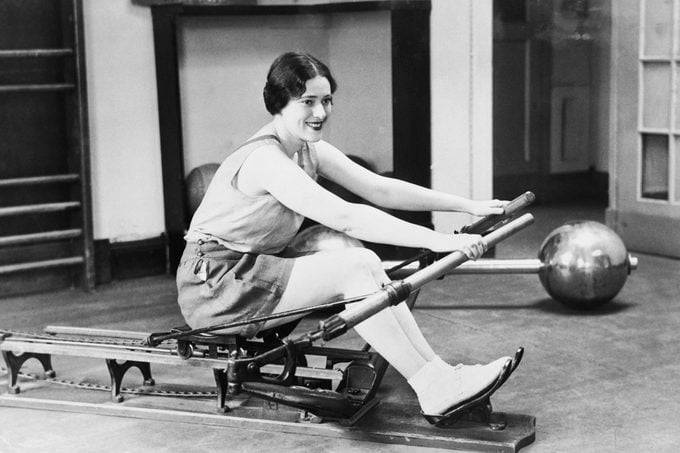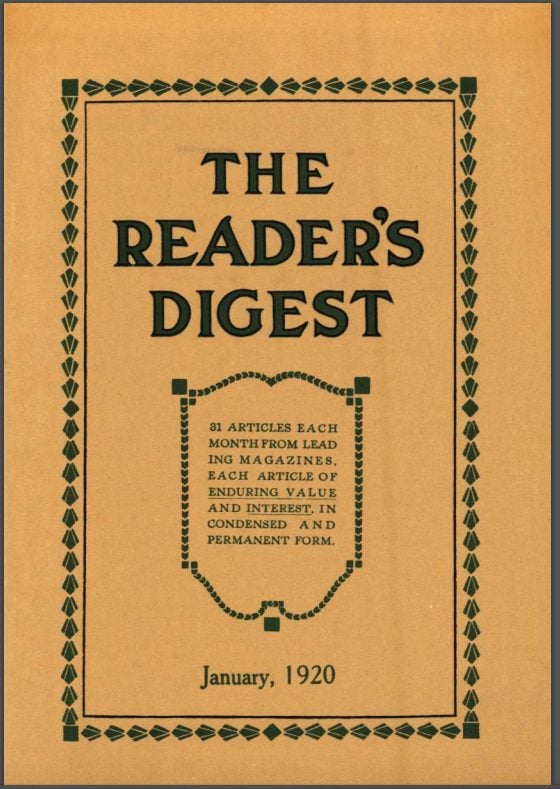1920s Advice: How to Regulate Your Weight
Updated: Mar. 28, 2022
Eat lean meats, unsweetened fruits, and green foods; limit sugar; and watch “starchy” foods. Were our great-grandmothers onto something?

Editor’s Note: This article was published in the very first edition of Reader’s Digest magazine (January, 1920). The fat-shaming is cringe-inducing to modern readers, but there are pearls of wisdom in some of the old-time weight advice, say today’s obesity experts. Pulled from our archives, the original article:
No healthy person need be too fat or too thin. He has just as much right to say what he shall weigh as what church he shall attend or what political ticket he shall vote. Each of us has an ideal weight which it is perfectly easy to attain and still easier to retain.
“I can’t reduce”— scientifically absurd
“I can’t reduce my weight,” is a statement scientifically absurd. Go without food today and you will lose a pound, probably much more. Just as certainly will you lose, though more slowly, if you eat a little less than you need for a longer time.
Obesity is more common than underweight, and much more dangerous as we march into middle age. It has just two causes: The first is disease, usually an affliction of the thyroid gland; these cases are comparatively few and need not be considered. The second is nothing in the world but overeating.
Overeating is not necessarily gluttony, or anything approaching it. A small meal made up of certain foods will furnish more fuel—and more fat —to the body than one twice as large and less discreetly chosen. Foods vary vastly in fuel value; for instance, one pound of olive oil will stand sponsor for more surplus flesh than 45 pounds of the lettuce on which we are likely to eat it.
Table enemies of the stout person
The stout person must learn that he has both friends and enemies at the table. His enemies are sugar, bread, cereal, desserts, butter, cream, olive oil, bacon, cocoa and rich sauces. Among his best friends are lean meats, unsweetened fruits and green foods. Yet, alas! most plump people seem stricken with an ardent love for their enemies.
A woman who was “fat, fair and forty” and extremely anxious to reduce said that she was already a very small eater. But when asked what she had for breakfast she answered: “Only three or four slices of toasted bread and a cup of coffee.” But she used a lot of cream and four lumps of sugar in her coffee, both of which are very fattening, and bread is not to be despised as a builder of flesh.
We eat—or, at least, we should eat —to provide protein (tissue builder) to replace the small amount that is worn out each day, and to supply fats and carbohydrates (the latter meaning sugar and starches) to be converted into heat and energy. They are our coal. The normal diet has from one-fourth to three-eighths protein. Fats and carbohydrates, which are practically interchangeable, make up the rest. Proteins occur abundantly in meat, eggs, milk, cheese and nuts. Fats are found freely in cream, butter, olive oil, chocolate, bacon and fat meats. Carbohydrates are stored in fruits, grains and vegetables.
General rules for weight reduction
These general classes of the elements in what we eat may be borne in mind reading these rules for weight reduction:
- For proteins take one-third of a pound of meat and two eggs daily. Most of our other foods will contain a small amount of protein, which will make up the balance of what you need.
- Select one highly carbohydrate article, besides sugar, for each meal. You may choose from bread, cereals, soup, macaroni, corn, potato, custard, ice cream, dried figs, dates or raisins. Never let willful appetite or mistaken courtesy lead you to take a second helping of such starchy foods as rice, tapioca, macaroni or potato.
- Limit your sugar to three teaspoonfuls daily.
- Fats should be cut down to a minimum. From one and a half to three balls of butter—which is entirely fat—should be sufficient for this division of your diet. Use no cream, olive oil, bacon or fat meat. Never eat cheese or nuts. (Today, of course, we know that nuts are actually great for you.)
- If you obey the foregoing instructions, you may appease your appetite by eating unsweetened fruits, salads without oil, and such vegetables as carrots, squash and string beans, without cream sauce. You will miss some of your sweet, rich old enemies for a while, but you will soon come to feel just as fond of things which are good for you.
 Over-eating most common after exercise
Over-eating most common after exercise
The average city dweller is slow to recognize that since he has little exercise he requires little food. When he does go out for a tramp or a few sets of tennis the unwonted activity is more likely to increase his appetite than his legitimate demand for food. A walk of three miles requires an addition to the dietary of only one large slice of bread and butter; yet the average urbanite, after taking such a walk, is likely to eat a third more than usual at the next meal. Do you wonder that the quick, snappy step is so seldom seen in the shadow of sky-scrapers?
It takes only a slight dietetic surplus to set one on the road toward obesity. Von Noordeu [diabetes specialist Carl von Noorden] has estimated that three slices of bread, one-third of a quart of milk or three-quarters of an ounce of butter more than the body demands, taken daily, will cause a gain of twenty pounds in one year.
Reduction diets should be accompanied with systematic exercise whenever possible. For those who would gain weight, little need be added; they should eat heartily of the very things that fat folk are warned to shun.
Mortality handicaps of the stout statistics
Tables prepared by an insurance company from 100,000 cases show that not a single really fat person lived to be 80 years old. Fourteen underweights, however, reached this age. Between 40 and 50 a man who allows his weight to remain high is running more danger than he would run if he contracted typhoid fever. A man who is thinner than the average, on the other hand, has less danger of dying in this decade than a man of normal weight. But people underweight up to the 30th year have a higher death rate. A man in his fifties who is twenty pounds over normal weight has a 15 percent mortality handicap to face.
This article was digested from The American Magazine and ran in the very first issue of Reader’s Digest in 1920. The American Magazine, founded in 1906, was published through August of 1956 and covered human interest stories, articles on social issues, fiction serials, and short stories.

















